The House of Atreus
Homer tells us that the most powerful king among the Greeks at Troy was Agamemnon who ruled from his mighty fortress at Mycenae, “rich in gold.” The story of Agamemnon and how he came to be king is convoluted, to say the least, so you are really going to have to pay attention. There is plenty of sex and violence.
According to legend, the great citadel was built by the hero Perseus, prince of Argos and slayer of the Gorgon Medusa, who enlisted the help of the Cyclops to build its massive stone ramparts. The Perseid dynasty came to an end with the death of Perseus’ grandson in battle whereupon the Mycenaeans chose Atreus, son of Pelops to be their new king.
Pelops was king of Pisa, in the northwest Peloponnese (named after him). He acquired the throne by cheating his way to victory in a chariot race with the previous king, Oenomaus. Oenomaus had a daughter, Hippodameia, whom Pelops wanted as his wife (the couple are shown in the jar fragment, below right) but it had been prophesied that the king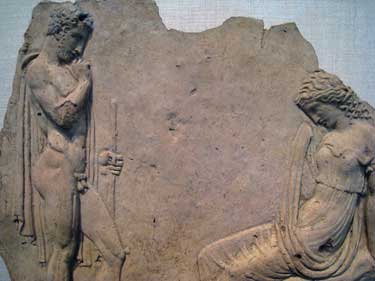 would die at the hands of his son-in-law. He had already killed no less than thirteen previous suitors whose driving skills were not up to scratch—their severed heads were nailed to the columns of his palace. Needless to say, Pelops was somewhat concerned that this fate awaited him too and so he cooked up a scheme with the king’s groom, Myrtilus, to remove the bronze lynchpins that held the wheels in place and replace them with wax versions. The deal was that the groom would be rewarded with half the kingdom and one privilege of sharing Hippodameia’s bed on her wedding night. The plot was a success and Oenomaus was killed in the resulting chariot crash, but Pelops had no intention of honouring his side of the bargain. Hippodameia cried “Rape!” and Pelops kicked him off a cliff—but not before he cursed Pelops and all his descendants. It was to commemorate these events that the Olympic Games were instituted, so don’t go moaning about what has happened to Olympic ideals.
would die at the hands of his son-in-law. He had already killed no less than thirteen previous suitors whose driving skills were not up to scratch—their severed heads were nailed to the columns of his palace. Needless to say, Pelops was somewhat concerned that this fate awaited him too and so he cooked up a scheme with the king’s groom, Myrtilus, to remove the bronze lynchpins that held the wheels in place and replace them with wax versions. The deal was that the groom would be rewarded with half the kingdom and one privilege of sharing Hippodameia’s bed on her wedding night. The plot was a success and Oenomaus was killed in the resulting chariot crash, but Pelops had no intention of honouring his side of the bargain. Hippodameia cried “Rape!” and Pelops kicked him off a cliff—but not before he cursed Pelops and all his descendants. It was to commemorate these events that the Olympic Games were instituted, so don’t go moaning about what has happened to Olympic ideals.
 would die at the hands of his son-in-law. He had already killed no less than thirteen previous suitors whose driving skills were not up to scratch—their severed heads were nailed to the columns of his palace. Needless to say, Pelops was somewhat concerned that this fate awaited him too and so he cooked up a scheme with the king’s groom, Myrtilus, to remove the bronze lynchpins that held the wheels in place and replace them with wax versions. The deal was that the groom would be rewarded with half the kingdom and one privilege of sharing Hippodameia’s bed on her wedding night. The plot was a success and Oenomaus was killed in the resulting chariot crash, but Pelops had no intention of honouring his side of the bargain. Hippodameia cried “Rape!” and Pelops kicked him off a cliff—but not before he cursed Pelops and all his descendants. It was to commemorate these events that the Olympic Games were instituted, so don’t go moaning about what has happened to Olympic ideals.
would die at the hands of his son-in-law. He had already killed no less than thirteen previous suitors whose driving skills were not up to scratch—their severed heads were nailed to the columns of his palace. Needless to say, Pelops was somewhat concerned that this fate awaited him too and so he cooked up a scheme with the king’s groom, Myrtilus, to remove the bronze lynchpins that held the wheels in place and replace them with wax versions. The deal was that the groom would be rewarded with half the kingdom and one privilege of sharing Hippodameia’s bed on her wedding night. The plot was a success and Oenomaus was killed in the resulting chariot crash, but Pelops had no intention of honouring his side of the bargain. Hippodameia cried “Rape!” and Pelops kicked him off a cliff—but not before he cursed Pelops and all his descendants. It was to commemorate these events that the Olympic Games were instituted, so don’t go moaning about what has happened to Olympic ideals.Pelops had two sons by Hippodameia, Atreus (the elder) and Thyestes, but he also had another, his favourite, a bastard named Chrysippus. Fearing that they would be supplanted and encouraged by their mother, the two brothers murdered Chrysippus and tossed him in a well—the curse has begun its work. Banished along with their mother from the kingdom, the two brothers were given refuge by Eurystheus, the aforementioned grandson of Perseus (and the king who set the Twelve Labours of Herakles). The selection of his brother rankled with Thyestes, for the two were bitter rivals, and he was not content to play second fiddle. The first thing he did was seduce his sister-in-law, Aerope. From her he learned about a golden-fleeced lamb among her husband’s flocks that had been promised by him as an offering to Artemis, the goddess of wildlife. However, instead of giving her the whole animal, he kept the fleece, mounted and stuffed, for himself. Aerope stole it and handed it over to her lover. At a council meeting Thyestes tricked Atreus into claiming that he had the right to sit on the throne through its possession. At that point, Thyestes took the councillors to his house and to the amazement of all, produced the fleece. Atreus had no choice but to resign in his favour. However, Zeus was not happy with the way events unfolded and tricked Thyestes to hand the throne back by causing the sun to reverse directions.
Despite the fact that Thyestes plot turned out to be a failure, Atreus was seething with vengeance. He invited his brother to a conciliatory feast and served him up with some choice pieces of meat. After asking him how he enjoyed dinner, Atreus revealed that it was his own infant sons that he had eaten. Thyestes ran off distraught and horrified, cursing his brother and vowing revenge. The first thing he did was consult the oracle at Delphi, which told him that the instrument of his vengeance would be the son he would beget on his own daughter, Pelopia. So he went to Sicyon, where his daughter served as a priestess to the goddess Athena, to do the will of the gods. One night, after sacrificing 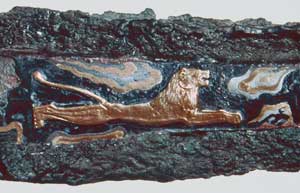 to the goddess, the girl splattered some of the blood on her tunic and slipped it off to wash it in the temple pool. Thyestes, who had been lurking nearby, sprang from the bushes and raped her. He was wearing a mask, so she had no idea who he was but she did manage to steal his sword. As the example (left) from one of the graves at Mycenae shows, these can be quite distinctive.
to the goddess, the girl splattered some of the blood on her tunic and slipped it off to wash it in the temple pool. Thyestes, who had been lurking nearby, sprang from the bushes and raped her. He was wearing a mask, so she had no idea who he was but she did manage to steal his sword. As the example (left) from one of the graves at Mycenae shows, these can be quite distinctive.
 to the goddess, the girl splattered some of the blood on her tunic and slipped it off to wash it in the temple pool. Thyestes, who had been lurking nearby, sprang from the bushes and raped her. He was wearing a mask, so she had no idea who he was but she did manage to steal his sword. As the example (left) from one of the graves at Mycenae shows, these can be quite distinctive.
to the goddess, the girl splattered some of the blood on her tunic and slipped it off to wash it in the temple pool. Thyestes, who had been lurking nearby, sprang from the bushes and raped her. He was wearing a mask, so she had no idea who he was but she did manage to steal his sword. As the example (left) from one of the graves at Mycenae shows, these can be quite distinctive. Meanwhile, Atreus had been advised by the same priests at Delphi to patch things up with his brother and was on his way to Sicyon, keen to let bygones be bygones. But, by the time he arrived, Thyestes had discovered that his sword was missing and, fearing his cover was blown, had already left town. His journey wasn’t entirely wasted, however. Having put his unfaithful wife to death, he was in the market for a new queen and Pelopia was the best thing he had seen all day. Blissfully unaware that she was his niece, he fell hopelessly in love and promptly married her. The fact that she was now pregnant made things a bit awkward so, when a baby son was born, she left him on the hillside to die. Fortunately for him, he was picked up by some goatherds who happened to be passing. They gave him to a she-goat to suckle and so he came to be called Aegisthos (“goat strength”). Atreus firmly believed that the child was his and that his bride was temporarily unhinged due to postpartum depression. He took Aegisthos into his palace and raised him with his other two sons, Agamemnon and Menelaos—the ones whose mother he had recently killed.
Seven years later, who should show up but Thyestes. He was promptly thrown in prison and Atreus ordered young Aegisthos to kill him. But the boy was not up to the duty. Thyestes easily kicked the blade out of his hand and was astonished to discover that it was the same sword that he had lost all those years ago. When he asks him how he came by it, the boy replies that his mother had given it to him. Thyestes then ordered him to bring his mother to the prison and there is a 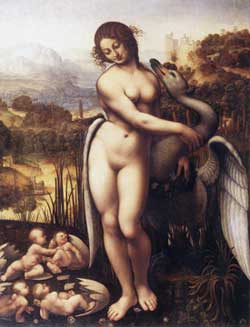 tearful family reunion. But then the truth comes out. Overcome by the shocking truth, Pelopia grabbed the sword and plunged it into her breast. Shrugging this unfortunate occurrence aside, Thyestes then told the boy to take the sword, dripping with his mother’s blood, show it to Atreus and tell him he has carried out his duty. Atreus is overjoyed and offered up a sacrifice to Zeus, believing that all of his troubles were behind him. Only then did Thyestes order his son to kill him and so finally realize his life’s ambition to sit on his brother’s throne.
tearful family reunion. But then the truth comes out. Overcome by the shocking truth, Pelopia grabbed the sword and plunged it into her breast. Shrugging this unfortunate occurrence aside, Thyestes then told the boy to take the sword, dripping with his mother’s blood, show it to Atreus and tell him he has carried out his duty. Atreus is overjoyed and offered up a sacrifice to Zeus, believing that all of his troubles were behind him. Only then did Thyestes order his son to kill him and so finally realize his life’s ambition to sit on his brother’s throne.
 tearful family reunion. But then the truth comes out. Overcome by the shocking truth, Pelopia grabbed the sword and plunged it into her breast. Shrugging this unfortunate occurrence aside, Thyestes then told the boy to take the sword, dripping with his mother’s blood, show it to Atreus and tell him he has carried out his duty. Atreus is overjoyed and offered up a sacrifice to Zeus, believing that all of his troubles were behind him. Only then did Thyestes order his son to kill him and so finally realize his life’s ambition to sit on his brother’s throne.
tearful family reunion. But then the truth comes out. Overcome by the shocking truth, Pelopia grabbed the sword and plunged it into her breast. Shrugging this unfortunate occurrence aside, Thyestes then told the boy to take the sword, dripping with his mother’s blood, show it to Atreus and tell him he has carried out his duty. Atreus is overjoyed and offered up a sacrifice to Zeus, believing that all of his troubles were behind him. Only then did Thyestes order his son to kill him and so finally realize his life’s ambition to sit on his brother’s throne.Atreus’ other two sons, Agamemnon and Menelaos, were forced to flee the palace eventually ending up in Sparta where they were given sanctuary by its king, Tyndareos. Tyndareos was blessed with two daughters, Klytemnestra and the beautiful Helen. Helen’s eye-popping beauty was due to the fact that her real father was the god Zeus. Having killed his own father and seduced or raped every woman or goddess that took his fancy, Zeus was the perfect role model for the sons of Pelops. In this particular instance he came to Tyndareos’ wife, Leda, in the form of a swan. Nine months later Leda laid a pair of eggs. Out of one came Helen and her brother, Pollux, while out of the other (this one fertilized by the king) came Klytemnestra and Castor.
After expelling Aegisthos and restoring Agamemnon, the rightful heir to the throne of Mycenae, Tyndareos gave his daughters in marriage to the brothers. All of the leading lights of the Greek World wanted to marry Helen—the Athenian hero, Theseus, went so far as to kidnap her when she was a mere child—but in the end Tyndareos chose Menelaos. Agamemnon’s bride, Klytemnestra, was not quite so willing. She already had a husband, Tantalus the ruler of Pisa in the northwest Peloponnese. As you may remember, Pelops, Agamemnon’s grandfather had once been king there and this Tantalus was the old king’s nephew and therefore some sort of cousin to Agamemnon. That did not stop him from murdering him, however. As for Klytemnestra, after watching her infant son slaughtered before her eyes she was raped by the triumphant Agamemnon.
It was the seduction (or rape, depending on whose version of events you believe) of Helen by Paris and their subsequent elopement (or abduction) that brought about the Trojan War. Agamemnon 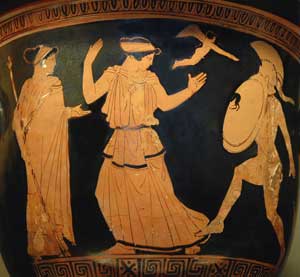 swore to recover his brother’s wife and commanded all of the Achaean warlords to gather with their ships and men at Aulis on the Boeotian coast opposite the island of Euboea. At Aulis, the fleet was held up by contrary winds—thanks to the goddess Artemis whom Agamemnon had offended by killing one of her sacred deer. Apparently the only way to appease the goddess was for the king to sacrifice his eldest daughter, Iphigenia, to the goddess. Agamemnon was reluctant at first but, when the rest of the Greeks threatened to appoint another commander, he relented. Having told Klytemnestra that her daughter was to be married to Achilles, he persuaded her to bring the girl to Aulis where she was offered up to the goddess, no doubt reinforcing the already strong marital bonds between them.
swore to recover his brother’s wife and commanded all of the Achaean warlords to gather with their ships and men at Aulis on the Boeotian coast opposite the island of Euboea. At Aulis, the fleet was held up by contrary winds—thanks to the goddess Artemis whom Agamemnon had offended by killing one of her sacred deer. Apparently the only way to appease the goddess was for the king to sacrifice his eldest daughter, Iphigenia, to the goddess. Agamemnon was reluctant at first but, when the rest of the Greeks threatened to appoint another commander, he relented. Having told Klytemnestra that her daughter was to be married to Achilles, he persuaded her to bring the girl to Aulis where she was offered up to the goddess, no doubt reinforcing the already strong marital bonds between them.
 swore to recover his brother’s wife and commanded all of the Achaean warlords to gather with their ships and men at Aulis on the Boeotian coast opposite the island of Euboea. At Aulis, the fleet was held up by contrary winds—thanks to the goddess Artemis whom Agamemnon had offended by killing one of her sacred deer. Apparently the only way to appease the goddess was for the king to sacrifice his eldest daughter, Iphigenia, to the goddess. Agamemnon was reluctant at first but, when the rest of the Greeks threatened to appoint another commander, he relented. Having told Klytemnestra that her daughter was to be married to Achilles, he persuaded her to bring the girl to Aulis where she was offered up to the goddess, no doubt reinforcing the already strong marital bonds between them.
swore to recover his brother’s wife and commanded all of the Achaean warlords to gather with their ships and men at Aulis on the Boeotian coast opposite the island of Euboea. At Aulis, the fleet was held up by contrary winds—thanks to the goddess Artemis whom Agamemnon had offended by killing one of her sacred deer. Apparently the only way to appease the goddess was for the king to sacrifice his eldest daughter, Iphigenia, to the goddess. Agamemnon was reluctant at first but, when the rest of the Greeks threatened to appoint another commander, he relented. Having told Klytemnestra that her daughter was to be married to Achilles, he persuaded her to bring the girl to Aulis where she was offered up to the goddess, no doubt reinforcing the already strong marital bonds between them. Then, having murdered her first husband and their baby, raped her and finally slaughtered their daughter on the altar of politics, Agamemnon then disappeared for ten years. Not surprisingly, perhaps, Klytemnestra was susceptible to the advances of Aegisthos (remember him?) who has decided to sit out the Trojan War and seek his revenge on the House of Atreus. When Agamemnon finally returned, the two decided to do him in. Any doubts Klytemnestra may have had—and I suspect they were minor at this point—were quickly resolved by the presence of Cassandra, former princess of Troy, current trophy-wife, and the mother of Agamemnon’s twin sons. Klytemnestra greeted her long-lost husband with every appearance of delight and suggested he retire to the bath house for a nice long soak. Just as the king stepped out of the tub, Klytemnestra threw some sort of net over his head while Aegisthos stabbed him to death. Seizing an axe, she then chopped off her husband’s head and ran outside to deal the same fate to Cassandra who, being a prophetess, was not surprised in the slightest.
According to Robert Graves, the peculiar manner of Agamemnon’s death—neither naked nor clothed (the net), neither in the water nor on dry land, neither in the palace nor outside it—is the same sort of death meted out to the sacred king who is sacrificed at midsummer in a number of Indo-European myths including the Welsh epic, the Mabinogion. In fact, Graves believes the whole cycle of stories has to do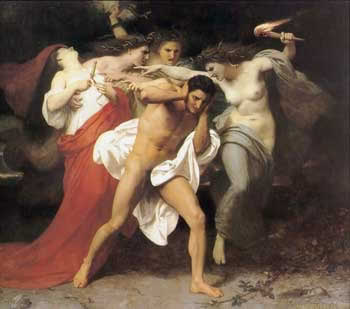 with the (violent) transition from a matriarchal to a patriarchal society that takes place with the arrival of Greek-speakers into the peninsula.
with the (violent) transition from a matriarchal to a patriarchal society that takes place with the arrival of Greek-speakers into the peninsula.
 with the (violent) transition from a matriarchal to a patriarchal society that takes place with the arrival of Greek-speakers into the peninsula.
with the (violent) transition from a matriarchal to a patriarchal society that takes place with the arrival of Greek-speakers into the peninsula. Whatever Klytemnestra’s motives, Aegisthos’ plan was to exterminate the line of Atreus and that meant that Orestes, her son by Agamemnon had to go too. Fortunately for him, the boy was spirited out of the palace (either by his nurse or by his sister, Elektra, according to which story you believe). After eight years exile in Athens he returns in secret to exact revenge for his father’s murder, which he does in typically bloody fashion. For the crime of matricide Orestes is hounded by the Erinýes (Furies) and driven insane (right). In Aeschylus’ play The Eumenides Orestes is brought to trial in Athens and cleansed of his blood guilt, thus establishing the ultimate authority of human institutions.
The Site
When Schliemann began his investigation of Mycenae in the 1870’s he found that the ancient description, “rich in gold,” was no exaggeration. Subsequent excavations, chiefly by Christos Tsountas, Alan Wace and George Mylonas, have only confirmed this.
The site is located in the northwest corner of the Plain of Argos, in the shadows of Mount Prophet Elias and Mount Zara and dominates the plain and the overland routes from the southern Peloponnese to the Isthmus of Corinth and the rest of Mainland Greece. Through its dependencies at Tiryns and Argos it was well-connected with Cyclades and the larger Mediterranean World— Egypt, Crete, Syria and Canaan.
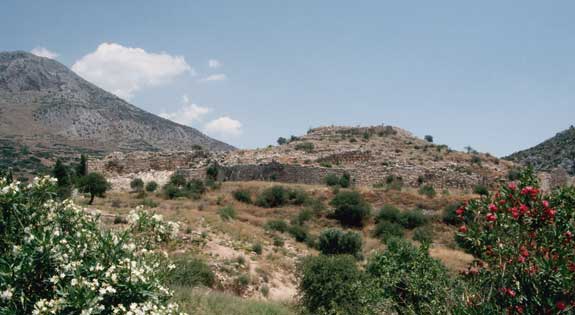
View of the Citadel at Mycenae from the south
The citadel was located at the top of a fairly steep, highly defensible hill which dominates the surrounding plain. There were apparently several small villages scattered in the hills around it— often their locations are only indicated by the rock-cut tombs nearby. There is no dense build-up of occupation normally associated with a city. The picture is more like that of a medieval castle surrounded by small hamlets and isolated farmsteads.
The earliest remains on the hill date to the 14th century BC when the summit was first fortified. Unfortunately, these (and subsequent building activity) have destroyed any trace of earlier occupation. However, the presence nearby of Middle Helladic cemeteries and even earlier material point to a long occupation, perhaps beginning in the third millennium BC. In the 13th century, two subsequent extensions of the original ramparts brought a large part of the southern slope, including the existing cemetery known as Grave Circle A, within their protection. At its greatest extent, the site only covered some 3 hectares.
Grave Circle B
Also beyond the citadel walls were the graves of the earliest kings of Mycenae and their families, dating to the beginning of the Late Helladic I period (ca. 1650- 1550 BC). They were enclosed by a low circular wall about 28 metres in diameter. The circle partly underlay a later tholos tomb, known as the Tomb of Klytemnestra, and was discovered in the course of restoration work to it in 1951. Only a small segment and a few stones of the encircling wall have survived In part this is due to the construction of the Tomb of Klytemnestra but most of the destruction resulted from the 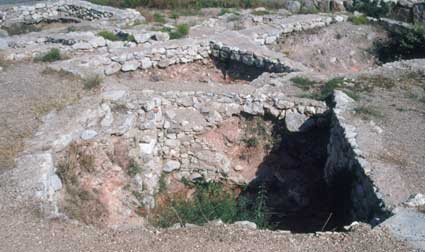 building of the modern road to the site. It was a double wall of roughly cut stone slabs with a fill of earth and smaller stones.
building of the modern road to the site. It was a double wall of roughly cut stone slabs with a fill of earth and smaller stones.
 building of the modern road to the site. It was a double wall of roughly cut stone slabs with a fill of earth and smaller stones.
building of the modern road to the site. It was a double wall of roughly cut stone slabs with a fill of earth and smaller stones. The small cemetery contained 10 small cist graves typical of the immediately preceding Middle Helladic period— simple boxes built of stone slabs with little evidence of wealth or status. The rest of the graves, 14 in all, are what are known as shaft graves. These were larger and deeper, often containing more than one burial. They were much richer too.
The Shaft Graves are rectangular and anywhere up to 4 metres deep. The largest, Grave Gamma, measures 3.8 x 2.8 metres and the smallest, Grave XI, is about two-thirds that size. The lower sections of the side walls were shored up with masonry or brickwork forming a ledge a metre or so 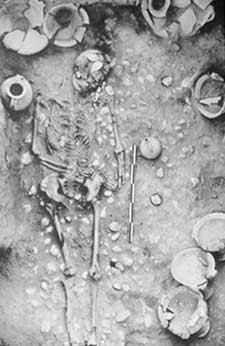 up. This was used to support a roof which was made of either timber beams or flagstones. The rest of the shaft was filled with dirt forming a small mound at the top. There is evidence of some sort of funeral feast— cooked bones and broken drinking vessels were heaped up on top of the fill before the mounding was complete. Finally, some sort of marker— usually a carved stele — was erected on top. All of this, of course, had to be removed to permit the interment of additional bodies.
up. This was used to support a roof which was made of either timber beams or flagstones. The rest of the shaft was filled with dirt forming a small mound at the top. There is evidence of some sort of funeral feast— cooked bones and broken drinking vessels were heaped up on top of the fill before the mounding was complete. Finally, some sort of marker— usually a carved stele — was erected on top. All of this, of course, had to be removed to permit the interment of additional bodies.
 up. This was used to support a roof which was made of either timber beams or flagstones. The rest of the shaft was filled with dirt forming a small mound at the top. There is evidence of some sort of funeral feast— cooked bones and broken drinking vessels were heaped up on top of the fill before the mounding was complete. Finally, some sort of marker— usually a carved stele — was erected on top. All of this, of course, had to be removed to permit the interment of additional bodies.
up. This was used to support a roof which was made of either timber beams or flagstones. The rest of the shaft was filled with dirt forming a small mound at the top. There is evidence of some sort of funeral feast— cooked bones and broken drinking vessels were heaped up on top of the fill before the mounding was complete. Finally, some sort of marker— usually a carved stele — was erected on top. All of this, of course, had to be removed to permit the interment of additional bodies. The bodies were laid out, normally extended and on their backs, on a bed of pebbles at the bottom of the shaft (as seen, right, in Grave Upsilon). They were decked out in all of their finery, their robes decorated with gold ornaments and wearing their best jewellery. Grave goods consisting of offerings of food and drink in clay and metal containers along with personal items such as weapons were placed next to the deceased. The most significant finds were an electrum mask found in Grave Omicron and a vase made out of rock crystal, carved in the shape of a duck. The number and quality of the grave goods is far less than those from the slightly later Grave Circle A. However it does represent a marked increase in wealth compared with graves from earlier periods.
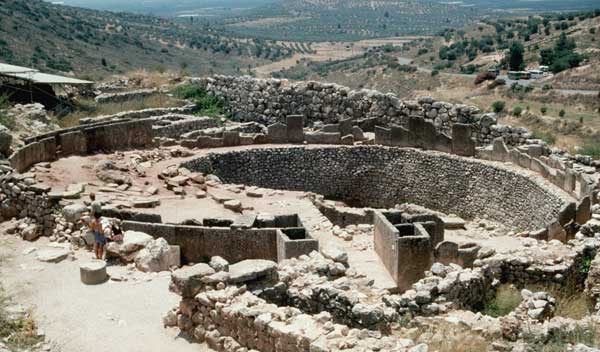
Mycenae.Circle A from the top of the Lion Gate
Grave Circle A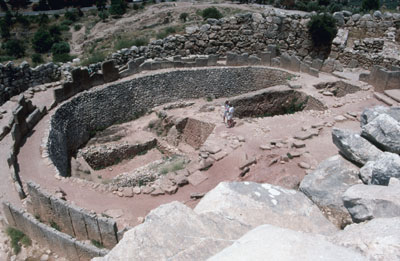
Circle A is very similar in layout to Circle B but slightly later, dating to the period from about 1580-1500 BC. It is located just inside the Lion Gate but only after the extension of the ramparts in the 13th century BC— before that it was outside the walls. It was about the same size as Circle B, about 27 metres in diameter, and was surrounded by a similar parapet wall. The wall here is much better preserved and consists of a double row of vertical slabs about 1 metre high. The space in between the row was filled with earth and the whole thing capped with more stone slabs. The entrance lies to the north, facing the Lion Gate, and it similar in construction to the rest of the wall.
Within the circle were 6 shaft graves and a number of earlier cists. The shafts are more or less oblong and range in size from 3 x 3.5 metres (II) and 4.5 x 6.5 metres (VI) 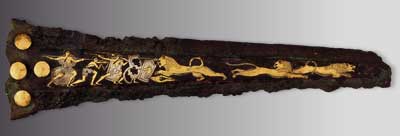 and are up to 4 metres deep. They were built in a similar fashion to those in Circle B. The remains of 19 inhumations (8 men, 9 women and 2 children) were found accompanied by rich grave goods—far more than was the case in Circle B.
and are up to 4 metres deep. They were built in a similar fashion to those in Circle B. The remains of 19 inhumations (8 men, 9 women and 2 children) were found accompanied by rich grave goods—far more than was the case in Circle B.
 and are up to 4 metres deep. They were built in a similar fashion to those in Circle B. The remains of 19 inhumations (8 men, 9 women and 2 children) were found accompanied by rich grave goods—far more than was the case in Circle B.
and are up to 4 metres deep. They were built in a similar fashion to those in Circle B. The remains of 19 inhumations (8 men, 9 women and 2 children) were found accompanied by rich grave goods—far more than was the case in Circle B.A large number of bronze swords and daggers, many with engraved decoration or inlays on their blades, accompanied the males. The best examples, inlaid with hunting or ‘nature’ scenes come from Graves IV and V. Apparently they had been wrapped in linen. Spearheads, arrowheads and 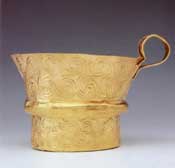 knives were also found beside men but there were no shields or body armour. However, flakes of boar’s tusks, which may have come from a helmet, were found in Grave IV .
knives were also found beside men but there were no shields or body armour. However, flakes of boar’s tusks, which may have come from a helmet, were found in Grave IV .
 knives were also found beside men but there were no shields or body armour. However, flakes of boar’s tusks, which may have come from a helmet, were found in Grave IV .
knives were also found beside men but there were no shields or body armour. However, flakes of boar’s tusks, which may have come from a helmet, were found in Grave IV . Gold and silver cups had been placed next to both men and women. In Grave IV, three rhytons were found— the silver Siege Rhyton (which shows an attack on a city), a gold rhyton in the shape of a lion’s head and another of silver and gold in the shape of a bull’s head.
 | 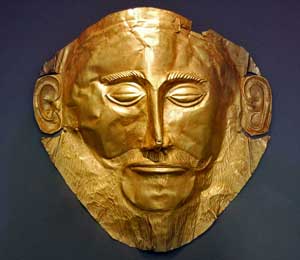 |
Gold Masks from Circle A with the Mask of Agamemnon on the right
Gold masks had been placed on the faces of five men in Graves IV and V. By far the most accomplished of these is the so-called ‘Mask of Agamemnon’. It is so different from the others that some scholars have questioned its authenticity.
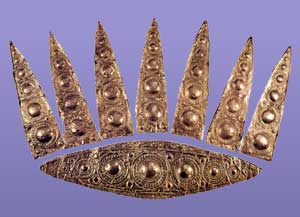 | 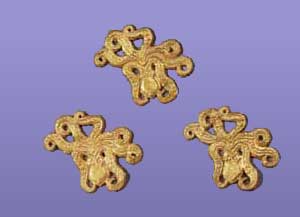 |
Gold Ornaments from Circle A including a diadem from Grave III (left) and Octopuses from Grave IV (right)
Women wore gold diadems or gold bands on their heads and their clothing was decorated with gold discs. Over 700 such discs, decorated with spirals, floral patterns and animals, were found in Grave II alone. Gold rings with carved bezels and gold figures (including one of a tripartite shrine), gold buttons and boxes covered with gold-leaf were also found.
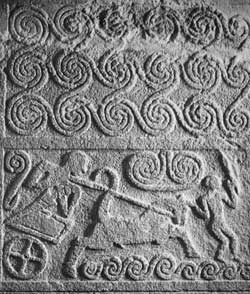
Stele from Circle A. Mycenae
Stelae, both plain and carved with reliefs, were found in the fill of the circle— it has been suggested that the plain ones had marked women’s graves, but there is no real evidence to support the idea. Three of the decorated ones bore reliefs of men in chariots, possibly hunting but more likely racing in funeral games.
The Ramparts north of the Lion Gate
The fortification walls at Mycenae are best preserved along the northern side where they are up to 7.5 metres thick stand nearly 12 metres high in places. They were constructed for the most part of huge, irregularly shape stone blocks of the sort described as “Cyclopean” by later Greeks. There were two principal entrances, the Lion Gate at the west end and the Postern Gate on the north side. There is also a ‘sally 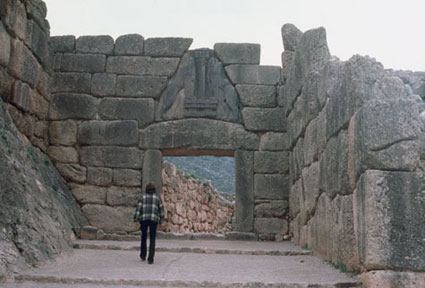 port’ at the eastern end which was used to sneak in and out of the citadel during a siege. The entire circuit at its greatest extent measured close to 900 metres.
port’ at the eastern end which was used to sneak in and out of the citadel during a siege. The entire circuit at its greatest extent measured close to 900 metres.
 port’ at the eastern end which was used to sneak in and out of the citadel during a siege. The entire circuit at its greatest extent measured close to 900 metres.
port’ at the eastern end which was used to sneak in and out of the citadel during a siege. The entire circuit at its greatest extent measured close to 900 metres. The Lion Gate
The Lion Gate was built c. 1250 BC, during the second occupation phase when the ramparts were extended to include Grave Circle A. It was reached by a ramp that ran below steep walls on its north-eastern side and led to an Outer Court (15 x 7.5 metres) designed to limit the number attac. Since gateways were the weakest part of the defences, this consideration was of extreme importance. The situation was made even more lethal for the attackers by the presence of a huge projecting bastion on the south-western side. 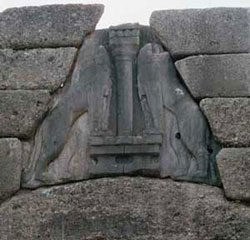 This enabled the defenders to pour fire into their unshielded right sides.
This enabled the defenders to pour fire into their unshielded right sides.
 This enabled the defenders to pour fire into their unshielded right sides.
This enabled the defenders to pour fire into their unshielded right sides.The gate itself was built out of massive megalithic blocks. The lintel measures 4.5 x 2 x 0.8 metres; the jambs are 3 x 1.74 x 0.54 metres; and the threshold (which cracked under its own weight in antiquity) is 4.56 x 2.31 x 0.88 metres. The blocks frame an opening 3.1 metres high and 2.95 metres wide at the threshold (it tapers slightly) which was closed by wooden double-doors decorated by bronze ornaments. Pivot holes were preserved in the lintel and threshold (the latter recently damaged). Rectangular sockets in the doorjambs held a crossbar, while other recesses received the handles of the open doors. Above the lintel, the superstructure of the wall was corbelled to leave a ‘relieving triangle’ which was covered by a slab whose weight rested only on the lower corners. The slab was carved with a relief depicting a pair of lions flanking a column (perhaps a symbol for the palace itself) with their forepaws rested on a pair of altars which supported the column. The heads 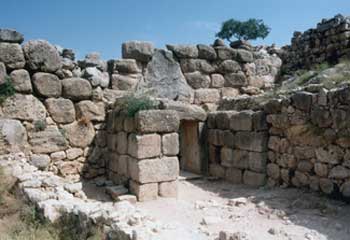 (now missing) were of a different material and fastened to the bodies by dowels. They faced outwards towards anyone approaching the gate. Perhaps the composition was the dynastic coat-of-arms.
(now missing) were of a different material and fastened to the bodies by dowels. They faced outwards towards anyone approaching the gate. Perhaps the composition was the dynastic coat-of-arms.
 (now missing) were of a different material and fastened to the bodies by dowels. They faced outwards towards anyone approaching the gate. Perhaps the composition was the dynastic coat-of-arms.
(now missing) were of a different material and fastened to the bodies by dowels. They faced outwards towards anyone approaching the gate. Perhaps the composition was the dynastic coat-of-arms.Just inside the Lion Gate was a small inner court (4 x 4 metres) with a tiny guardhouse or shrine on the east side. Beyond the court, on either side, were ramps leading to the top of the ramparts. To the west of the court were the foundations of a building known as the Granary (some vessels with carbonized seed were found inside) but that does not appear to have been its original function. The remains probably represent the basement of a multi-storeyed structure, possibly a guardhouse. Grave Circle A was just about 20 metres inside the Lion Gate and beyond it were a number of houses on the lower, south-eastern terrace of the hill.
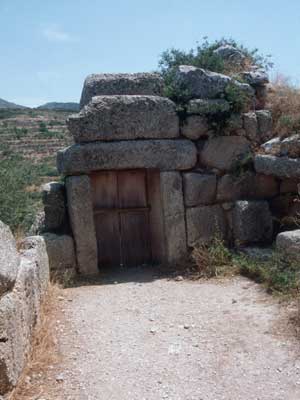 | 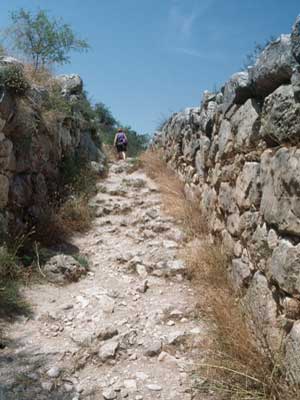 |
View of the Postern Gate (left) and the lane running inside the North Ramparts
The Postern Gate (or North Gate) was of similar construction and layout to the Lion Gate (but smaller and undecorated). A lane led from it to an area of houses in the north-western corner of the site and continued to link up with the road from the Lion Gate.
The Cistern and Sally Port
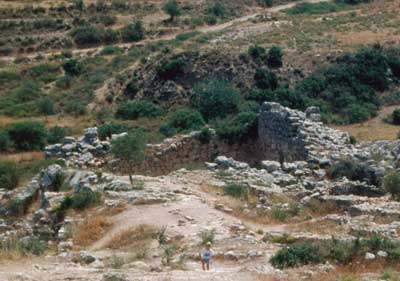 The north-eastern corner of the site was only brought within the ramparts during the final phase of construction, around about 1200 BC (the photo [left] shows the corner and the line of the original wall). This was made necessary because up until then there had been one glaring weakness in the defensive scheme— there was no natural source of water. This was remedied by carving an underground cistern out of the rock and filling it by means of a tunnel which ran from a spring on Mount Elias. Access to the cistern was by
The north-eastern corner of the site was only brought within the ramparts during the final phase of construction, around about 1200 BC (the photo [left] shows the corner and the line of the original wall). This was made necessary because up until then there had been one glaring weakness in the defensive scheme— there was no natural source of water. This was remedied by carving an underground cistern out of the rock and filling it by means of a tunnel which ran from a spring on Mount Elias. Access to the cistern was by 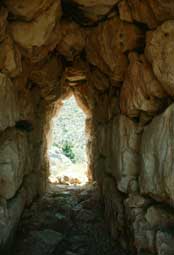 means of a corbel-vaulted passageway which descends in three sections to a depth of over 15 metres under the northern section of ramparts. The lower section of the stairway had been waterproofed with a thick coat of plaster so that it could serve as an extension of the cistern. Next to the entrance to the passage is a small opening in the ramparts, a “sally port” (right), and there is another on the wall opposite. Like the stairway, these were splendid examples of the corbel vaulting technique. They were designed to allow people to slip in and out of the fortress, unseen by enemy sentries. There are also the remains of two small buildings in the area. It has been suggested that Building Beta was an office of some sort while Building Alpha was used for storage (pithos fragments were found in the cellar rooms).
means of a corbel-vaulted passageway which descends in three sections to a depth of over 15 metres under the northern section of ramparts. The lower section of the stairway had been waterproofed with a thick coat of plaster so that it could serve as an extension of the cistern. Next to the entrance to the passage is a small opening in the ramparts, a “sally port” (right), and there is another on the wall opposite. Like the stairway, these were splendid examples of the corbel vaulting technique. They were designed to allow people to slip in and out of the fortress, unseen by enemy sentries. There are also the remains of two small buildings in the area. It has been suggested that Building Beta was an office of some sort while Building Alpha was used for storage (pithos fragments were found in the cellar rooms).The main approach to the palace is the Great Ramp which begins at the back end Inner Court, just beyond the Lion Gate. It is between 4 and 5.75 metres wide, paved with cobbles and buttressed by a large retaining wall. It runs southwards for 24 metres before turning to the east at a landing part way up the hill. After about 30 metres it branches— one fork leading 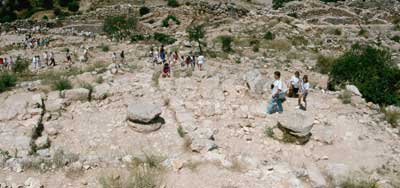 to the Propylon of the palace and the other to the Grand Stairway.
to the Propylon of the palace and the other to the Grand Stairway.
 to the Propylon of the palace and the other to the Grand Stairway.
to the Propylon of the palace and the other to the Grand Stairway.The Palace itself was built on the summit and along massive terraces on the south-western and eastern slopes of the hill. A modern reconstruction of the terracing can be seen in the title shot of this page. The official entrance was via an H-shaped Propylon (left) of the sort found at Pylos and Tiryns— 2 single-columned, roofed porticoes back-to-back (marked A on the plan below). From a small court beyond, a passage leads to the rest of the palace. On the left was a small flight of stairs that led up to the private apartments of the palace. Unfortunately, any trace of these was all but obliterated by the construction of a classical temple dedicated to Hera or Athena on the site and subsequent erosion of the hilltop.
A large stone threshold is all that remains of the West Portal (B), the entrance to the more formal parts of the building. Just to the north is a small room which may have served as a guardroom. Unfortunately, any rooms to the south have long since disappeared down the hill when the original terrace collapsed. What is visible of the terrace today has largely been restored in order to prevent the loss of what remains of the buildings on top.
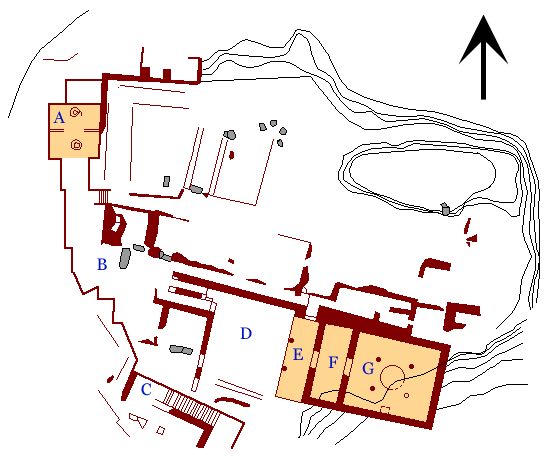
Plan of the Palace
Beyond the West Portal was a small court with a pair of passageways leading off— one to the domestic apartments at the top of the hill and the other to the throne room suite. To the south of the court was the Grand Staircase (C), which led directly from the palace to the Cult Centre and was undoubtedly the scene of great ceremonial processions. At the far side of the court was a suite of rooms, possibly a set of guest rooms or offices for palace officials. The Forecourt (D), which measured 11 x 15 metres, was reached directly from the second passage and is reasonably well-preserved. The upper surface had originally been plastered and divided into painted squares, similar to the decoration of the palace floors at Pylos.
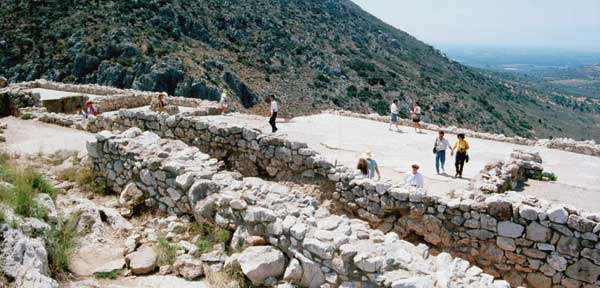
Overall View of the Palace
On the east side was a megaron of identical design to those found at the other palaces. Facing the court was a covered Portico (E), paved with gypsum slabs and with painted plaster walls. There is a threshold at the north end of the room, indicating that a doorway once led from there to the upper passageway and the domestic apartments. Part of the base of a stone altar was found near one of the column bases along with a basin for pouring libations. The antechamber was also decorated with frescoes but they had been severely damaged by the fire that eventually destroyed the palace and only tiny fragments have survived. The main room measured 12.95 x 11.5 metres but, like the antechamber, was badly eroded on the south side where a sizeable chunk of the original terrace had crumbled away. 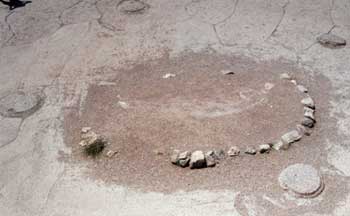 Nevertheless, it is obvious that it had more or less the same layout as those at Tiryns and Pylos. In the centre was a circular hearth (d=3.4 metres) built of a heavily plastered ring of stones and surrounded by 4 wooden columns on stone bases— the same arrangement as at Pylos. The lower part of the walls were covered with gypsum slabs, with frescoes above, while the floor was of stucco, divided by painted lines into squares. The throne, on analogy with the better preserved palaces, presumably sat against the southern (right-hand) wall. There is no evidence of a second storey (at least there are no staircases) or of any balcony such as there was at Pylos.
Nevertheless, it is obvious that it had more or less the same layout as those at Tiryns and Pylos. In the centre was a circular hearth (d=3.4 metres) built of a heavily plastered ring of stones and surrounded by 4 wooden columns on stone bases— the same arrangement as at Pylos. The lower part of the walls were covered with gypsum slabs, with frescoes above, while the floor was of stucco, divided by painted lines into squares. The throne, on analogy with the better preserved palaces, presumably sat against the southern (right-hand) wall. There is no evidence of a second storey (at least there are no staircases) or of any balcony such as there was at Pylos.
 Nevertheless, it is obvious that it had more or less the same layout as those at Tiryns and Pylos. In the centre was a circular hearth (d=3.4 metres) built of a heavily plastered ring of stones and surrounded by 4 wooden columns on stone bases— the same arrangement as at Pylos. The lower part of the walls were covered with gypsum slabs, with frescoes above, while the floor was of stucco, divided by painted lines into squares. The throne, on analogy with the better preserved palaces, presumably sat against the southern (right-hand) wall. There is no evidence of a second storey (at least there are no staircases) or of any balcony such as there was at Pylos.
Nevertheless, it is obvious that it had more or less the same layout as those at Tiryns and Pylos. In the centre was a circular hearth (d=3.4 metres) built of a heavily plastered ring of stones and surrounded by 4 wooden columns on stone bases— the same arrangement as at Pylos. The lower part of the walls were covered with gypsum slabs, with frescoes above, while the floor was of stucco, divided by painted lines into squares. The throne, on analogy with the better preserved palaces, presumably sat against the southern (right-hand) wall. There is no evidence of a second storey (at least there are no staircases) or of any balcony such as there was at Pylos.Mycenaean Religion
Physical evidence for Mycenaean religion and cult practice is fairly abundant for the Late Helladic period. There are the remains of the shrines themselves along with figurines, sacred objects, fresco fragments and seal impressions with scenes of cult activity. Unfortunately, what is missing is contemporary written evidence—apart from catalogues of deities and offerings found at Knossos 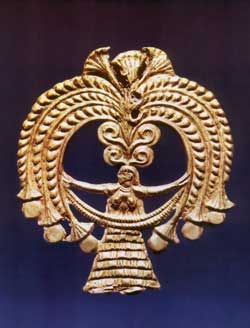 and Pylos. Modern interpretations tend to be based on later Greek mythology and cosmology—in the assumption that they have absorbed a lot of earlier ideas—as well as the beliefs and practices of other Indo European speaking peoples.
and Pylos. Modern interpretations tend to be based on later Greek mythology and cosmology—in the assumption that they have absorbed a lot of earlier ideas—as well as the beliefs and practices of other Indo European speaking peoples.
 and Pylos. Modern interpretations tend to be based on later Greek mythology and cosmology—in the assumption that they have absorbed a lot of earlier ideas—as well as the beliefs and practices of other Indo European speaking peoples.
and Pylos. Modern interpretations tend to be based on later Greek mythology and cosmology—in the assumption that they have absorbed a lot of earlier ideas—as well as the beliefs and practices of other Indo European speaking peoples.By the middle of the fifteenth century BC, Greeks from the mainland had made themselves masters of Crete and ruled the island from the palace at Knossos. Most of the material that has survived, mainly from tombs, was the product of Minoan workshops and a good deal of it probably arrived as booty. Indo-Europeans tend to be tolerant of other peoples deities are very respectful to local gods and goddesses when they encounter them, incorporating them into their own systems quite readily. In the eastern Mediterranean, they entered a region that had been dominated for thousands of years by the cult of the great mother goddess. She is associated with mountaintops, springs, caves and other permanent features of the landscape. The male side of the equation was represented by a the power of the bull or by the young god. The general opinion is that the bull is a rather obvious symbol of male potency, seeding the womb of the earth. In the later mythology, Zeus appears in Crete in the guise of a bull and fathers the Minotaur, who is half man and half bull, on the Minoan queen Pasiphaë. The young god, who is killed in the mythology (Adonis, for example), represents the harvesting of the crops or the culling of the young animals.
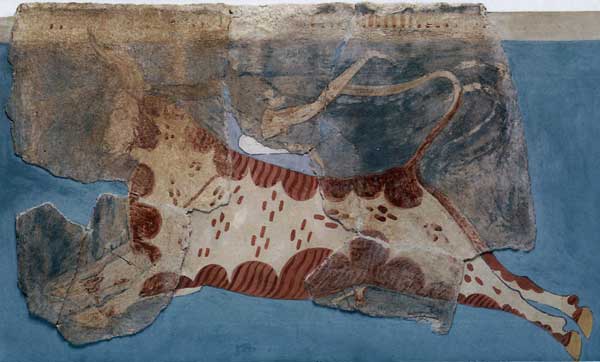
Bull Leaping Scene. Tiryns
The gods of the Indo-Europeans, on the other hand were associated with the sky and were much more mobile. The goddess was primarily concerned with fertility—the fertility of the earth, of the wildlife and of the people. She was also the goddess of hearth and home, the humanity’s attempt toimpose some kind of permanence on their cosmos. These concerns did not suddenly end with the arrival of the newcomers and goddess worship was immensely important throughout ancient times. The Eleusinian Mysteries, which celebrated the cult of Demeter and Persephone with ecstatic rituals, were much more popular than the worship of the Olympians and continued to be so until the Christians made it illegal. Also of fundamental importance in later times was the cult ofHestia (or Vesta, as she was known to the Romans), the goddess of the hearth. The central 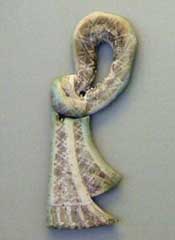 feature of all of the known Mycenaean palaces is a great hearth and itis difficult not to see it in this connection.
feature of all of the known Mycenaean palaces is a great hearth and itis difficult not to see it in this connection.
 feature of all of the known Mycenaean palaces is a great hearth and itis difficult not to see it in this connection.
feature of all of the known Mycenaean palaces is a great hearth and itis difficult not to see it in this connection.The shaft graves at Mycenae—especially, Circle A—contained awealth of jewellery, clothing ornaments and other small objects. Minoan religious symbols such as the labrys (double-axe), the sacral knot (left) and the ‘horns of consecration’ are fairly common. The iconography is predominantly feminine. Goddesses are depicted much more frequently than gods and in most instances are the main focus of attention. That does not necessarily mean that Minoan religion was matriarchal, perhaps it is just that the feminine side of it is more visible in the surviving evidence. Many of the scenes appear to be ecstatic and visionary with drugs and dancing clearly in evidence. It is difficult not to think in terms of orgiastic Dionysian rituals accompanying the sacred marriage of the god and goddess, the sacrifice of the god at harvest time and his rebirth in the spring.
The Cult Centre
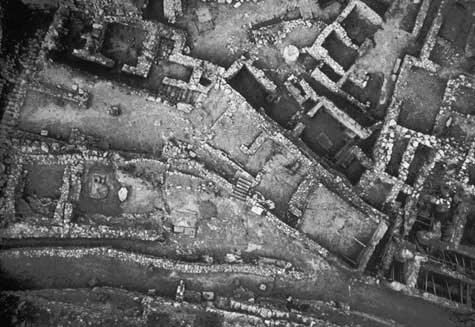
Aerial of the Cult Centre at Mycenae with the Tsountas House to the left
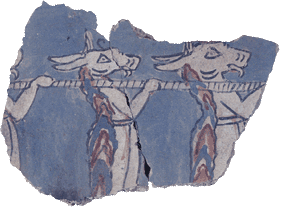 To the south of Grave Circle A is an area known as the Cult Centre which is linked by a circuitous processional way from the palace on the summit (the red arrows in the plan, opposite). At the bottom of the hill it makes a sharp turn and leads directly to a large megaron known as the Tsountas House. There is a plastered square altar in the forecourt of the adjacent building to the northeast and, within it, a horseshoe-shaped fixture with traces of burning and a rectangular block which may have served as a slaughtering stone. Fragments of painted wall plaster were found within the Tsountas house and the building on the other (southwest) side, including one showing a procession of asses. A plaster tablet shows two women who appear to be priestesses on either side of an altar and the so-called ‘shield goddess’. The latter was presumably the deity who watched All of this is pretty clear evidence of a religious function for the buildings.
To the south of Grave Circle A is an area known as the Cult Centre which is linked by a circuitous processional way from the palace on the summit (the red arrows in the plan, opposite). At the bottom of the hill it makes a sharp turn and leads directly to a large megaron known as the Tsountas House. There is a plastered square altar in the forecourt of the adjacent building to the northeast and, within it, a horseshoe-shaped fixture with traces of burning and a rectangular block which may have served as a slaughtering stone. Fragments of painted wall plaster were found within the Tsountas house and the building on the other (southwest) side, including one showing a procession of asses. A plaster tablet shows two women who appear to be priestesses on either side of an altar and the so-called ‘shield goddess’. The latter was presumably the deity who watched All of this is pretty clear evidence of a religious function for the buildings. 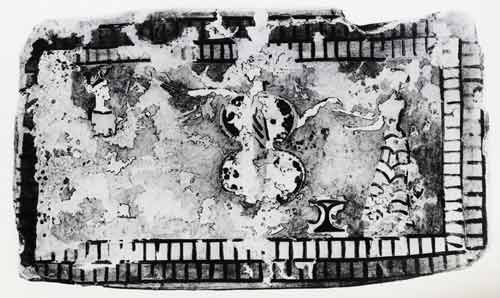
Painted Plaster tablet showing two women flanking the ‘Shield Goddess’
To the northwest, at a lower level, is an open area with a circular altar associated with deposits of ashes, potsherds and animal bones. Next to it is a small building known as the House of Idols, consisting of a large oblong room with a vestibule and a small annex at the rear. The main room has a central, plastered dais (no trace of burning) and a row of narrow platforms of varying heights at the back end. Atop the highest, hidden behind a pillar, was a clay statuette of a goddess with an offering table before her. In the northwest corner, a window opened onto an outcrop of bare rock-screened from outside view by a diagonal cross wall. This suggests the deities involved were of the earth and underworld.
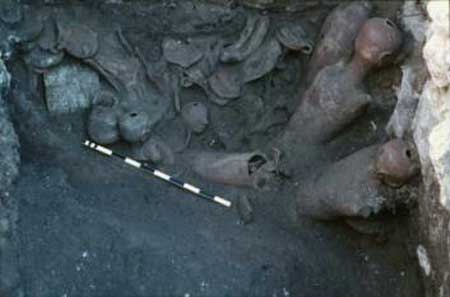
Annex of the House with the Idols (as excavated)
Behind a screen (?) of 3 columns, a flight of steps led to a small room containing a number of broken idols, clay snakes, offering tables and pottery. There were both male and female deities, perhaps representing a pantheon, which may have sat on the other staggered platforms in the main hall.
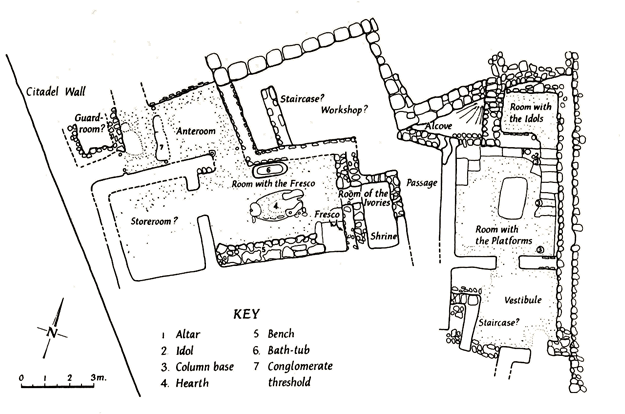
Plan of the Cult Buildings
Another shrine, the House of Frescoes, lay next door, to the west. The layout was somewhat different— an anteroom led to a rectangular main hall with a central oblong hearth. Against one long wall was a clay larnax (it looks much like an old fashioned bath tub) while a bench ran along the wall opposite. At the end of the bench was a square altar with frescoes on its face and on the wall above. Fragments of a presentation scene-goddesses seated and standing with spear and sword. Horns of consecration were depicted along with a seated goddess and a priestess carrying what appear to be sheaves of wheat in her hands. A small annex to the southeast was probably a shrine. A terracotta idol was found there along with glass beads and pottery.
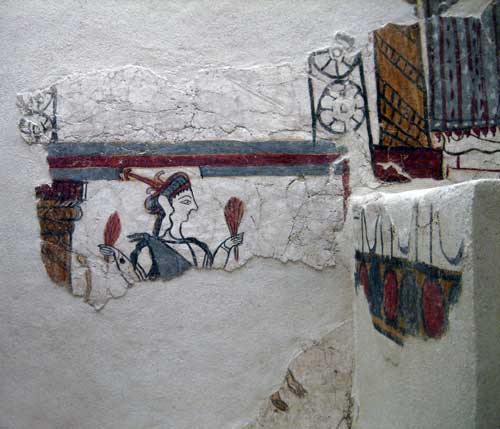
House of Frescoes. Presentation Scene
